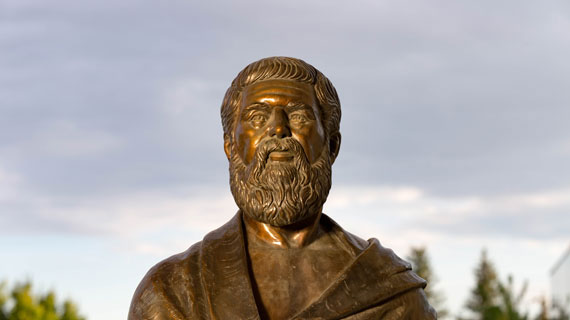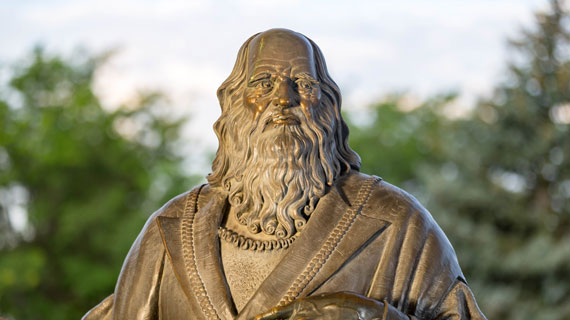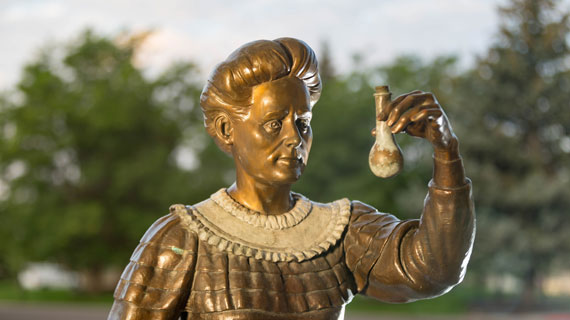What is the Centurium on the Campus of SUU?
Posted: November 03, 2017 | Author: Southern Utah University | Read Time: 6 minutes

A gift to the University to commemorate the 100th anniversary of the founding of Southern Utah University in 1897, The Centurium speaks to the origins and purpose of the University and the power of education.
The men and women whose statues stand in The Centurium have, through their devotion to the life of the mind, forged new and better paths for the generations of the future. Admired and esteemed for their intellectual contributions, they continue to foster the development of learning, many hundreds of years beyond their own lives and times. The contributions made by these intellectual giants reflect the motto of this University: Learning Lives Forever. Sculptor Jerry Anderson took three years to complete the sculptures comprising this considerable collection.
Dr. Eugene T. Woolf, former director of the Grace A. Tanner Center for Human Values, assisted in the selection of the twelve historical figures from Western civilization represented in The Centurium. He subsequently wrote a book about these eminent men and women, The Odyssey of the Mind, A Voyage of Discovery, published by Southern Utah University Press. It is available for purchase from the SUU Bookstore.
Odyssey of the Mind
The mind is the only measure of all that humanity values and preserves. Ideas, no less than events, affect the course of history. Ideas are a transcript of the world. The odyssey of the mind is a voyage of discovery, as exciting as any that has been undertaken. No limits have been placed on the exercise of the mind. Intellect is not a respecter of sex, race, religion, or nationality. Nor is it circumscribed by age or health. Great thinkers over the centuries have, through their courage, foresight, and the commitment to the majesty of knowledge, profoundly altered the course of history. The men and women represented here have forged new and better paths for future generations. Loved and respected for their contributions to the life of the mind, they epitomize the exaltation of reason, the passion for freedom, the spirit of discovery, and the fire of genius - themes that continue to inspire the development of learning and impart the pleasure that the acquisition of knowledge provides. The contributions made by these intellectual giants reflect the motto of this university: Learning Lives Forever.
Statues in the Centurium
Twelve brilliant historical figures are featured in the Centurium including Aristotle, Plato, Socrates, Marie Curie, William Shakespeare, Leonardo Da Vinci, Germaine de Stael, John Stuart Mill, Thomas Jefferson, Albert Einstein, Galileo Galilei, and Isaac Newton. Follow the links below to learn more about their contributions to society.
Aristotle
One of the greatest figures in the history of thought, Aristotle, more than any other person, determined the direction and form of Western intellectual history. Driven by a desire for knowledge, he mastered every field of learning known to the Greeks, including physics, chemistry, biology, zoology and botany; psychology, political theory and ethics; logic and metaphysics; history, literary theory and rhetoric. Learn more about Aristotle.
Plato
Throughout the entire course of Western civilization, Plato’s influence as a thinker and writer has been greater than that of any other historic figure. Along with Socrates and Aristotle, he laid the foundations of Western culture by providing a brilliant and penetrating account of man’s moral and political character. Learn more about Plato.
Socrates
Socrates was one of the most original, influential, and controversial philosophers of the Greek World. He spent his life in Athens conversing with people of all classes, seeking true knowledge (knowledge of self), and exposing the ignorance of those who claimed to have wisdom. His persistent questioning was viewed by the authorities as undermining Athenian values and undercutting the authority of those responsible for the education of the young men of the city. Learn more about Socrates.
Marie Curie
Marya Sklodovski was born into an impoverished intellectual family in Warsaw, Poland. She excelled in physics and mathematics at the Gymnasium and was awarded a gold medal upon her graduation at age 16. In 1911 Marie Curie was awarded the Nobel Prize in Chemistry for the isolation of pure radium. Her work paved the way for important subsequent discoveries by nuclear physicists and chemists. Learn more about Curie.
William Shakespeare
No one is more highly regarded as a writer than William Shakespeare. He is generally considered the greatest dramatist the world has produced, and one of the finest poets in the English language. His plays have been produced over more time and in more places than those of any other playwright, lending truth to the prophecy of a contemporary: He was “not of an age, but for all time.” Learn more about Shakespeare.
Leonardo Da Vinci
Leonardo was the foremost genius of the Italian Renaissance, and perhaps the most versatile genius that ever lived. He explored all the fields of human knowledge that were available in his time, inserting his superb intellect into every realm where graphic representation is used - including painting, sculpture, architecture, and engineering. Learn more about Da Vinci.
Germaine de Stael
A woman of exceptional gifts and talents, Germaine de Stael was one of the most remarkable women of letters in her own or any time. She wrote novels, plays, poetry, history, literary criticism, moral and political essays, and autobiographical memoirs. Learn more about da Stael.
John Stuart Mill
Most commonly thought of as a philosopher, logician, and political economist, John Stuart Mill is one of the major intellectual figures of the 19th century, and is one of the most enduring and indispensable writers of his time. He never attended any school or university, but was educated at home and in France by the stern discipline of his famous father James Mill. Learn more about Mill.
Thomas Jefferson
Perhaps the most versatile of America’s founding fathers, Jefferson devoted 40 years to public service, serving as a member of the Virginia Conventions, the Continental Congress, the Virginia Legislature, Governor of Virginia, delegate to Congress, minister to France, Secretary of State, Vice President and President of the United States. Learn more about Jefferson.
Albert Einstein
A solitary and serene Genius, Albert Einstein is, by most accounts, the greatest theoretical physicist who ever lived. His contributions to man’s understanding of the universe are without parallel. More than any other scientist, he represents the embodiment of pure thought. Learn more about Einstein.
Galileo Galilei
Galileo Galilei, Italian mathematician, astronomer, and physicist, is responsible for several important contributions to modern scientific thought. When, in the autumn of 1609, Galileo directed his 20-powered telescope at the moon, he became the first man to use the new instrument to study the skies. Learn more about Galileo.
Isaac Newton
Isaac Newton is one of the most important figures in the entire history of science. His originality, scope, and importance went beyond that of any other man of his time. By his laws of motion, his theory of universal gravitation, his studies of light and color, and his contributions to calculus, he reorganized the study of the physical universe. Learn more about Newton.
This article was published more than 3 years ago and might contain outdated information or broken links. As a result, its accuracy cannot be guaranteed.
Tags: Campus




